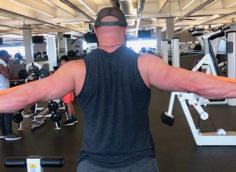Keeping your guard up during a fight is key for protecting yourself from incoming strikes. Street fights are violent and tend to end quickly, but not dropping the hands still matters. It's even more important for competitive fighters who have to deal with prolonged periods of stress.
Athletes and coaches have been experimenting with various training methods in an effort to make the shoulders resistant to fatigue, which makes it easier to keep your guard up.
But hold on a second, we've known the solution to this problem for ages. It's shadow boxing with dumbbells, right?
No, it's not. In fact, doing this will mess you up. Instead, there's a smarter way to make your shoulders fatigue-proof. All you need is a heavy bag and an iron will.
- Start by punching the heavy bag with a jab-cross combo continuously for 30 seconds. Punch fast and hard.
- Next, drop in a high plank position for another 30 seconds. Connect to the ground using only the first two knuckles of your fists, not your palms.
- While in the plank, use the "low lung volume hypoventilation" breathing technique (explained in detail below).
- Keep switching between the heavy bag and the plank for three minutes total, then rest for a minute and repeat for up to 10 rounds.
The punching has to be violent. This part of the drill will simulate the exchange of strikes during a fight. If you're a competitive athlete, wear your gloves. If you're training for self-defense, don't use gloves since you won't be wearing any in the streets anyway. Consciously focus on proper retraction and not dropping your hands.
The plank part will be your "break" between the punching bouts, but it'll also trap the fatigue in the shoulders, making sure they're becoming resistant to it.
Using the knuckles of the index and middle finger to support your weight will lead to a couple of benefits. First, it'll keep reminding you of the proper way to deliver punches, which is connecting to the target via the two big knuckles.
Second, it'll harden your knuckles along with the skin if you're doing this bare-handed. Just make sure you're using a soft surface, like a mat. The point is to build a strong, stable punching position, not injure your joints.
Research shows that a technique called "low lung volume hypoventilation breathing" can improve aspects of anaerobic performance and the ability of the muscles to eliminate metabolic waste like hydrogen ions (buffer capacity), thus making them more resilient to fatigue. Use it while you're holding the plank.
Here's How
- Inhalations should be normal. Due to the nature of the activity, they'll be deeper than when at rest, but not intentionally so.
- Exhale immediately after the inhalation, but leave some air in your lungs. That means you shouldn't get to the point where you're forcing it out.
- Hold your breath for 3-5 seconds but no more. This isn't a maximum duration hold since it wouldn't allow exercise to be maintained for long.
- After the breath hold, do a quick and powerful exhalation, emptying your lungs completely. This will rid you of the carbon dioxide that has built up and help you maintain exercise intensity.
I know what you're thinking, but no. Your fancy elevation mask won't work. It doesn't create a hypoxic environment, simply because it can't make the air thinner. It only lets you inhale less of it. It's like trying to breathe through a straw. Ditch it. You know you got it mostly for the selfies, anyway.
The duration of sets and number of rounds can be adjusted according to your needs. In the example, the circuit simulates a professional boxing match. If you compete in MMA, you might want to perform three to five rounds of five minutes each, and so on.
Perform this circuit two times per week. You should see significant improvements in as soon as one month's time.
- Woorons X;Bourdillon N;Vandewalle H;Lamberto C;Mollard P;Richalet JP;Pichon A;. (n.d.). Exercise with hypoventilation induces lower muscle oxygenation and higher blood lactate concentration: Role of hypoxia and hypercapnia.
- Woorons X;Bourdillon N;Lamberto C;Vandewalle H;Richalet JP;Mollard P;Pichon A;. (n.d.). Cardiovascular responses during hypoventilation at exercise. Woorons X;Gamelin FX;Lamberto C;Pichon A;Richalet JP;. (n.d.). Swimmers can train in hypoxia at sea level through voluntary hypoventilation.
- Woorons X;Mollard P;Pichon A;Duvallet A;Richalet JP;Lamberto C;. (n.d.). Prolonged expiration down to residual volume leads to severe arterial hypoxemia in athletes during submaximal exercise.





